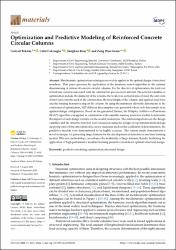Optimization and predictive modeling of reinforced concrete circular columns
Künye
Bekdaş, G., Cakiroglu, C., Kim, S., & Geem, Z. W. (2022). Optimization and Predictive Modeling of Reinforced Concrete Circular Columns. Materials, 15(19), 6624.Özet
Metaheuristic optimization techniques are widely applied in the optimal design of structural members. This paper presents the application of the harmony search algorithm to the optimal dimensioning of reinforced concrete circular columns. For the objective of optimization, the total cost of steel and concrete associated with the construction process were selected. The selected variables of optimization include the diameter of the column, the total cross-sectional area of steel, the unit costs of steel and concrete used in the construction, the total length of the column, and applied axial force and the bending moment acting on the column. By using the minimum allowable dimensions as the constraints of optimization, 3125 different data samples were generated where each data sample is an optimal design configuration. Based on the generated dataset, the SHapley Additive exPlanations (SHAP) algorithm was applied in combination with ensemble learning predictive models to determine the impact of each design variable on the model predictions. The relationships between the design variables and the objective function were visualized using the design of experiments methodology. Applying state-of-the-art statistical accuracy measures such as the coefficient of determination, the predictive models were demonstrated to be highly accurate. The current study demonstrates a novel technique for generating large datasets for the development of data-driven machine learning models. This new methodology can enhance the availability of large datasets, thereby facilitating the application of high-performance machine learning predictive models for optimal structural design.

















